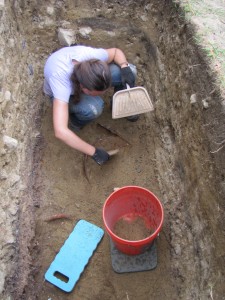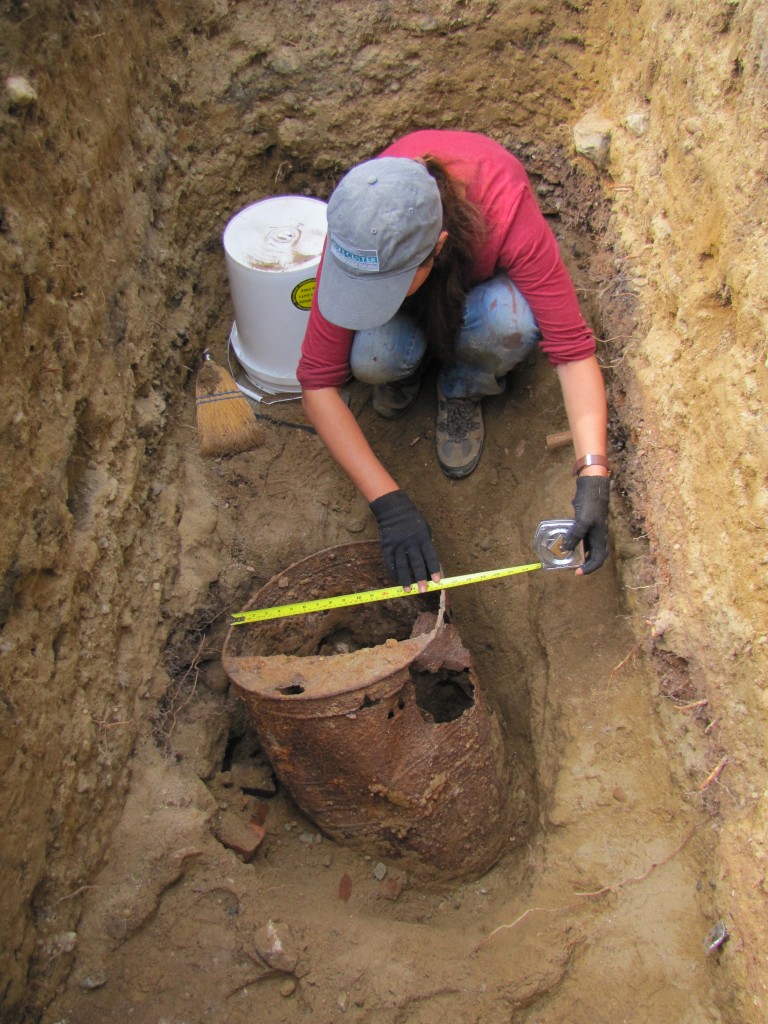By Anya Gruber
In Unit 13, Emily, Kerri, Ashley and I had just made it through a thick layer of old industrial coal ash – dark grey soil filled with soggy ash that looks a little bit like pet litter filled with coal, charcoal, coal slag and the occasional brick fragment – when Ashley suddenly encountered long streaks of rusted metal. We were immediately intrigued; metal was distinctly different from coal ash, and we’d grown rather weary of that. The rusty metal could be anything – perhaps a door hinge, just some scrap metal from a garbage pit, or maybe something even more exotic like a 1960s VW Bug (though that seemed slightly less likely).
When we started to dig further (using our trowels very, very carefully so as not to accidentally damage the artifacts, which would have been easy to do since the rust made them quite fragile), we realized that there were actually three separate metal objects at the bottom of our excavation unit. There seemed to be one circular artifact, and two flat ones; one flat object was right next to the circular one in the north end of the unit, and the other flat object seemed to be smaller and situated in the south end. We began to speculate that the circular object, which looked like a big barrel, could be some kind of coal furnace or engine from the nineteenth century, since there used to be an engine house close to our site. However, the thinness of the metal suggested it was not made for industrial purposes. The professors pointed out that the round metal object was tinned, which means it was coated with tin to prevent rusting (though no metal object, tinned or not, is safe from rust after a couple hundred years in the ground).
We continued onward, and realized that the flat object immediately next to the circular one seemed to be a lid; it had a piece on it that reminded us of a hinge, and there was a lip on the top of the circular artifact that seemed to correspond with the flat edge of the potential lid. We were getting really excited about the mystery object at this point, with everyone speculating what it could be. Since the unit was getting so deep, Emily and I became the official diggers (we are the two tallest members of our team – it was slightly easier for us to get in and out of the hole, but at this point we both felt like rabbits in a burrow deep beneath the ground and could hardly hear what was going on above ground), and we were steadfast in our mission to extract the curious items from the ground. However, the barrel and the lid seemed to be deeply wedged into the earth, and we were nervous that we wouldn’t be able to actually get it out to get a proper look at it.
Soon, we were able to remove the third item in the south end of the unit. It turned out to be some kind of box that had deteriorated quite a bit. We focused our attention on the barrel and the lid, digging around it and trying very hard to not flake bits of iron from its surface. We encountered a huge volume of brick and plaster in the area around the mystery objects, which suggested that we had found a nineteenth-century demolition of a building. Some particularly interesting artifacts from this deposit were a few unusual wedge-shaped bricks, which may have been used to build an arch. Though we’d had brick fragments in earlier units, we hadn’t seen these oddly shaped ones before, which made them interesting and exciting to find.
But back to the metal barrel, the star of the show! We dug further, trying to reveal as much of it as we could, but it became more and more apparent that we wouldn’t be able to remove the barrel. We did, however, release the lid, which we will keep. We knew that, even if we did reach its bottom, it would probably just crumble into a pile of rusty dust if we tried to lift it. So, like the scientists we are, we documented the find by drawing plans, sketching, measuring, photographing, and taking notes, making sure we had a detailed, accurate record of the object and the context it was found in.
We ultimately decided to keep the metal mystery barrel in situ, and we’ll rebury it when it’s time to close the unit. We haven’t determined exactly what the barrel was used for or what year it was made, but our working assumption is that it was used in the livery stables that were once located on School Street, perhaps to hold feed or grain for the horses. We’ll be doing more research on it to see what else we can find. In any case, it was a really cool find and certainly a treat for my group to have such an intriguing mystery to figure out!



